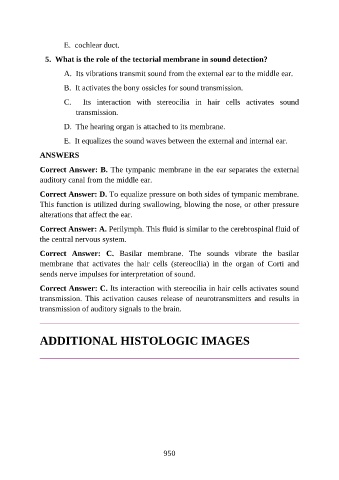Page 951 - Atlas of Histology with Functional Correlations
P. 951
E. cochlear duct.
5. What is the role of the tectorial membrane in sound detection?
A. Its vibrations transmit sound from the external ear to the middle ear.
B. It activates the bony ossicles for sound transmission.
C. Its interaction with stereocilia in hair cells activates sound
transmission.
D. The hearing organ is attached to its membrane.
E. It equalizes the sound waves between the external and internal ear.
ANSWERS
Correct Answer: B. The tympanic membrane in the ear separates the external
auditory canal from the middle ear.
Correct Answer: D. To equalize pressure on both sides of tympanic membrane.
This function is utilized during swallowing, blowing the nose, or other pressure
alterations that affect the ear.
Correct Answer: A. Perilymph. This fluid is similar to the cerebrospinal fluid of
the central nervous system.
Correct Answer: C. Basilar membrane. The sounds vibrate the basilar
membrane that activates the hair cells (stereocilia) in the organ of Corti and
sends nerve impulses for interpretation of sound.
Correct Answer: C. Its interaction with stereocilia in hair cells activates sound
transmission. This activation causes release of neurotransmitters and results in
transmission of auditory signals to the brain.
ADDITIONAL HISTOLOGIC IMAGES
950

